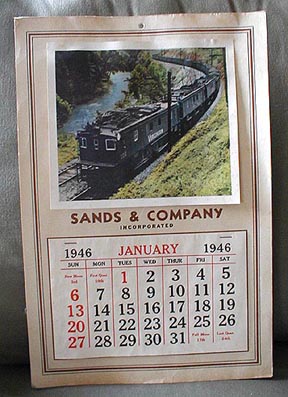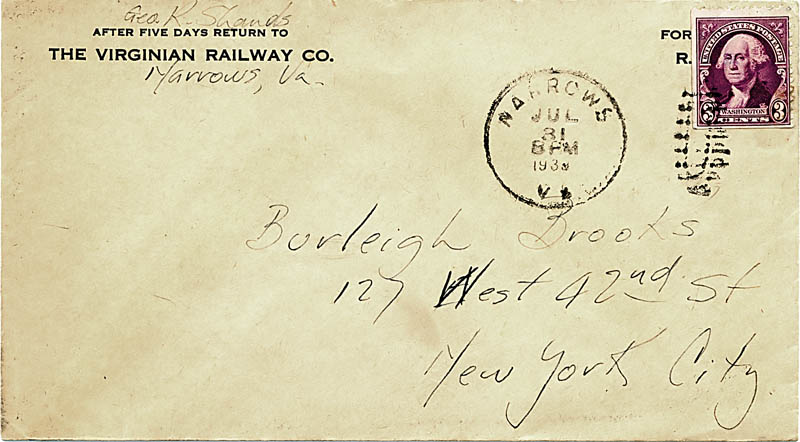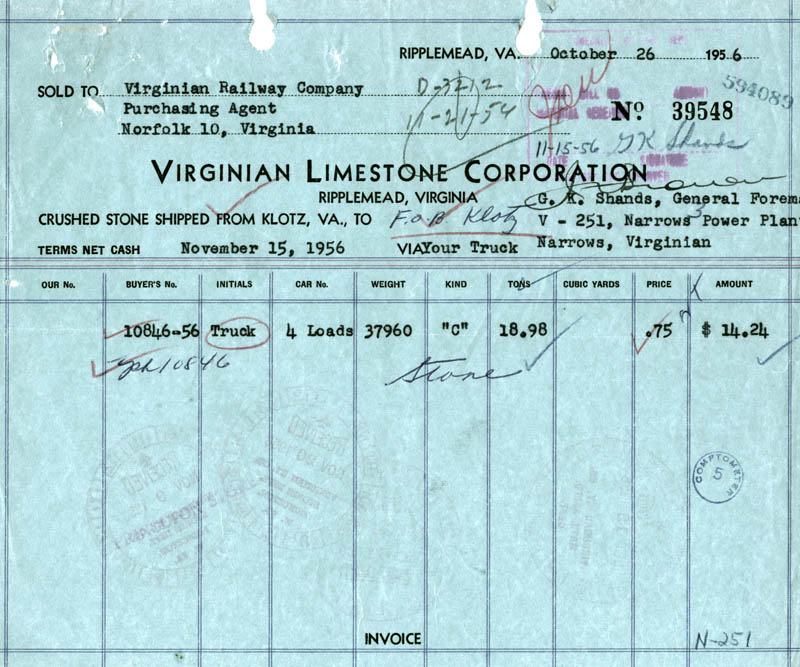Check out Connections below for an interesting story related to this calendar.
"Paper scenery" – timetables, train orders, magazines, etc. - adds much to the ambiance of a model railroad. One item I consider necessary is a calendar, but they are hard to find, especially with a railroad theme. This is how I "scratchbuilt" my own 1954 calendar.


I was fortunate to find a photo of a 1946 calendar with a Virginian train (right), and used it as the pattern for my version. This type of calendar was printed on card stock with a photo for the entire year at the top, and 12 monthly pages stapled at the bottom. Calendars like this often were given away by insurance agents and local businesses.
What were the dates?
The first question was how the months were arranged in 1954. Luckily, my Linux computer has a built-in calendar, so a cal 1954 command gave me the entire year. Lacking that, I would have checked the calendar capabilities of my word processor and spreadsheet programs.
Another option is to search the Web for an online app to create a calendar.
When were the holidays? The holidays with fixed dates, such as New Year's Day and Christmas, were easy, as were "first Monday" or "last Thursday" holidays. I had to remember that some holidays, such as Lincoln's and Washington's birthdays, were celebrated on the actual days, not combined into a generic holiday.
Easter falls on a Sunday calculated from phases of the moon, and can be tricky to figure out. I got lucky. An Internet search turned up one explanation that included the statement, "For example, in 1954 Easter fell on April 18." Bingo!
When were the phases of the moon? Calendars often show the four phases of the moon on the appropriate dates. A computer astronomy program quickly provided these dates for each month in 1954. Without this, I would have searched the Web for the information.
Creating the calendar pages. I used WordPerfect to create a page for each month. It was easy to make a table with seven rows and seven columns, then combine columns in the top row for the month and year heading. Other word processors have similar capabilities.
I chose a typeface (Century) that existed in 1954 and looks like it belongs on a calendar in that era. Sunday and holiday numerals are red, as are the dividing lines and month name. The holiday name is not printed (customary in 1954) unless the holiday falls on a Sunday, in which case I made the numerals smaller and added the holiday name.
Finally, I printed all 12 months on a color inkjet printer and cut the pages to size.
The photo. The color photo was taken in 1954 by Virginian employee Jack Burgess, on a trip to Slab Fork with George Shands, and appears most recently on the cover of Kurt Reisweber's book, Virginian Rails 1953 - 1993 (see Connections below). Since it's printed as a halftone, I scanned it into my computer at 1200 dots-per-inch to avoid the crosshatch pattern that results from a low-resolution scan. I fine-tuned the size, color, and brightness in Adobe Photoshop, and saved it to disk.
Putting it all together. Once I had the photo and monthly pages in hand, I used Adobe Illustrator to bring everything together as a complete calendar. I tried to match the 1948 calendar very closely, including features like the three-line border, the tinted background, the white border around the photo, and the typeface for the company name. I chose "Burgess & Shands Incorporated" as a tip of the hat to the photographers.
I bought a sheet of white poster board and cut it into 11" x 17" pieces, which my color inkjet printer can accommodate. The calendar was printed on the back of the poster board because the glossy coated front prevents the ink from being absorbed.
Tip: To save ink while test-printing, in Adobe Illustrator I added a layer with an artwork-size rectangle filled with white. I set the opacity of this layer to 85% (nearly solid white) and made it the topmost layer. Printing with this layer turned on saves a lot of color ink but still produces a good proof image. The layer is turned off for final printing.
The final step was to staple the 12 monthly pages to the cardstock. Naturally my stapler wouldn't reach that far, so I laid everything on a scrap of Homasote, opened the stapler flat, and gave it a good whack. Then I used needlenose pliers to bend the staples over on the back. The finished calendar measures about 10" x 14".
Summary. I'm very pleased with my 1954 calendar. Looking at it hanging on the wall in the crew lounge, it's hard to believe it was created in 2001. For each operating session, I re-staple the pages with the current month in front.
Once again the personal computer makes a difficult task easy. I hope you'll be encouraged to make one for your own railroad.
Sometimes unexpected connections give a model special meaning. Such is the case with this calendar. George Shands (mentioned above) was the foreman of the Virginian power plant at Narrows, and acted as a semi-official company photographer, taking many pictures of the railroad. After I'd chosen his photo for the calendar, and used his name as part of the fictitious company, I purchased two items on eBay with direct connections to Mr. Shands, spanning a period of 17 years.
The first item is this envelope from George Shands at Narrows in 1939, addressed in his own handwriting to Burleigh Brooks in New York City. Burleigh Brooks was an importer of Rolleiflex twin-lens reflex cameras, Schneider lenses, large view cameras, and other high-end professional photographic accessories. Apparently Mr. Shands appreciated fine photographic equipment.

The second item is this 1956 invoice for four truckloads of crushed stone from the Virginian Limestone Corporation quarry and crusher at Klotz. The stone was consigned to Mr. Shands in his official capacity as General Foreman at the Narrows power plant.

